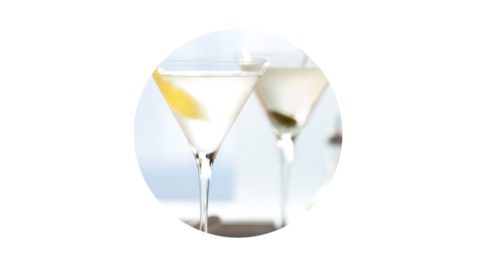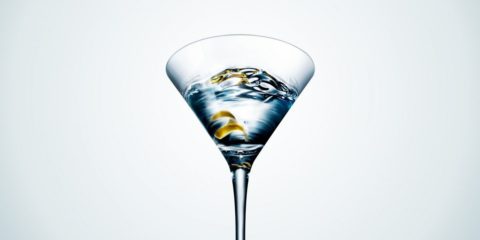The art of the martini: How it became the most iconic cocktail ever

First of all, it’s stirred, not shaken. Here’s everything else you need to know about the world’s most sophisticated drink

In the early 2000s, when Joe McCanta was a bartender at the New York bistro Counter, he had grown weary of the era’s obsession with overly sweet, unnecessarily complicated cocktails. So he opposed it with irony—and created a Root Beer martini cocktail. “It was meant to be fun and whimsical,” he says, “but it also was taking the whole apple-strawberry-pom-tini craze to its most outrageous conclusion.”
McCanta was ahead of his time in other ways: he was obsessed with using fresh ingredients, so much so that he began to grow and tend his own plants so that he could incorporate them into his cocktails.
But what he really wanted to be making—and, indeed, what he now crafts as Global Ambassador for Grey Goose Vodka—were honest, unadulterated, classic martini cocktails.
One of the most straightforward drinks in a bartender’s repertoire, the vodka martini cocktail combines its smooth, clean-drinking marquee spirit with vermouth, a simple garnish and an optional dash of bitters. It’s mixed with ice, strained into a chilled glass and, naturally, sipped cold. The Grey Goose signature serving uses a five-to-one ratio of vodka to Martini Dry Vermouth, adorned with a twist of lemon and further enhanced by orange bitters. It’s a cocktail that’s synonymous with sophistication and charisma, a drink that defies the trends and is all the more appealing for doing so.
Like many legends, the martini cocktail’s origins are subject to debate. According to some, its beginnings trace to the California Gold Rush town of Martinez, where mid-19th-century prospectors were served an olive-garnished drink named after the locale. Others credit Jerry Thomas, the father of American mixology, with developing a sort of proto-martini cocktail in the 1860s.

Later lore places its birth at New York City’s Knickerbocker Hotel, circa 1912, where bartender Martini di Arma di Taggia made a version of the drink that more closely resembles its modern-day formula. In the years following, the martini cocktail would gain many of its most notable enthusiasts: authors such as Ernest Hemingway, H.L. Mencken and E.B. White, who called it the “elixir of quietude.” Politicians and entertainers such as Franklin Roosevelt, Frank Sinatra and Jackie Gleason have all favoured it and boosted its reputation.
While the dry gin martini cocktail was popular from around 1910 to 1950, the vodka martini came on the scene in the 1950s and quickly won over the the cocktail crowd. It has remained the more prominent version of the drink ever since.
McCanta says vodka is a cleaner drink, less likely to induce the palate fatigue that’s possible with botanical elixirs such as gin. And while a certain British spy certainly raised the profile of the cocktail, 007 isn’t completely infallible. Serious martini cocktail makers have long known that his mantra, “shaken, not stirred” is far from the best way to prepare the libation.
According to McCanta, vigorous shaking is the quickest way to get a very cold martini cocktail, which is desirable. However, all that agitation creates tiny air bubbles that cloud the liquid. For many cocktail fans, this is unappealing. Crucially, it also speeds up the ice’s dilution. Your shaken martini cocktail may be flash-chilled, but it’ll warm up much faster than if it had been stirred.
“Most of us will sip a martini cocktail at a leisurely pace,” McCanta says, “and stirring not only keeps the cocktail colder longer, but you get a nice silky texture that’s smooth and perfect. It’s the art of the cocktail.”
Which is the point, really. Your martini cocktail should be perfect. It should also be your martini cocktail.
Notwithstanding its simple recipe, the martini cocktail is one of the few classic cocktails that can be personalized to suit the tastes of its imbiber. Whether you find yourself at Vancouver’s Blue Water Cafe, Toronto’s Ritz Bar in the Ritz-Carlton Hotel, Le Richmond in Montreal — or any of the finest bars in Canada — you can confidently order the precise martini cocktail you’re in the mood for. Perhaps you want it “wet,” with a greater share of dry vermouth. Maybe you want it dirty, with olive brine. Your garnish could be a grapefruit twist or pearl onion. Keep things simple but don’t be afraid to go bespoke.
“There’s nothing more sophisticated or more sexy,” says McCanta, “than when a person knows exactly how they take their martini cocktail. It’s the mark of a real tastemaker.”
This is a sponsored post paid for by our advertising partners. For more recipes, holiday entertaining and gift ideas visit spiritbygreygoose.com.








